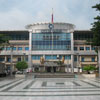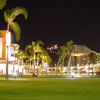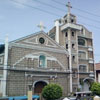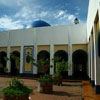Trivia about the different landmarks in Taguig City
| TAGUIG CITY HALL – Taguig seat of government was originally situated in Brgy. Sta. Ana and was later transferred to Brgy. Tuktukan in the early 1970s. After enduring various calamities throughout its 20-year history, the building then suffered severe structural damages. In2003, the Taguig Municipal Hall underwent a major facelift, through the initiatives of current mayor Sigfrido Tinga. The newly-renovated building was inaugurated on April 24, 2004,in time with Taguig’s 4l7th Founding Anniversary.On December 8 of the same year, Taguig was declared a city, by virtue of Comelec’s en banc decision confirming the results of the 1998 plebescite and ratifuing its conversation from municipality to a highly urbanized city. |  |
|
FORT BONIFACIO – Now considered the seat of progress in Taguig, Fort Bonifacio used to be a military camp back in the American colonial period.The US government acquired a 2,578 hectare property of Taguig for military purposes and named it Fort McKinley after US President William McKinley. On May 14, 1949, Fort McKinley was finally turned over to the Philippine govemment by virtue of US Embassy Note No. 0570. In 1957, it became the permanent headquarters of the Philippine Army. It was subsequently renamed Fort Bonifacio after Andres Bonifacio, whose father, Santiago Bonifacio, was a native of Tipas, Taguig. When Fort Bonifacio was privatized and placed under the administration of the Bases Conversation Development Authority, the whole area was restored to Taguig. |  |
|
ARCHDIOCESAN SHRINE OF STA. ANA – Situated on Liwayway St. in Brgy.Sta. Ana, the Archdiocesan Church of Sta. Ana is one of the first and oldest churches built in the Philippines during the Spanish regime. It was erected by the Agustinian Friars in 1587, and has since become the foundation of Christianity in Taguig.Though it endured many calamities in history, the church was destroyed by an earthquake in 1645. In 1848, it was reconstructed through the initiatives of then parish priest Fr. Andres Diaz, only to be destroyed again by another earthquake. It was rebuilt in 1896 by Fr. Guillermo Diaz. In 2003, it underwent a full renovation through the efforts of the parish priest Rev. Fr. Roy M. Rosales. |  |
|
BLUE MOSQUE – Set in Maharlika Village, the Blue Mosque is the convergence point and sacred sanctuary of Muslims not only from Taguig, but also from near by cities.Designed by renowned architect Angel Nakpil, the blue Mosque has served as a religious and socio-civic center for both Filipino and foreign Muslims. It houses a conference room, three instructional classrooms or madalas, a library, clinic, the Secretariat, and the Imam’s office.The Blue Mosque’s unique architecture and multi-cross geometrical design is patterned after the Cordova (Spanish word for church) in Andalucia, Spain. |  |
Stamps and Official First Day Covers will be available starting June 5, 2009 at the Postage and Philatelic Department, Door 203, Liwasang Bonifacio, 1000 Manila and at all Regional Offices of the Philippine Postal Corporation.
Recent Comments